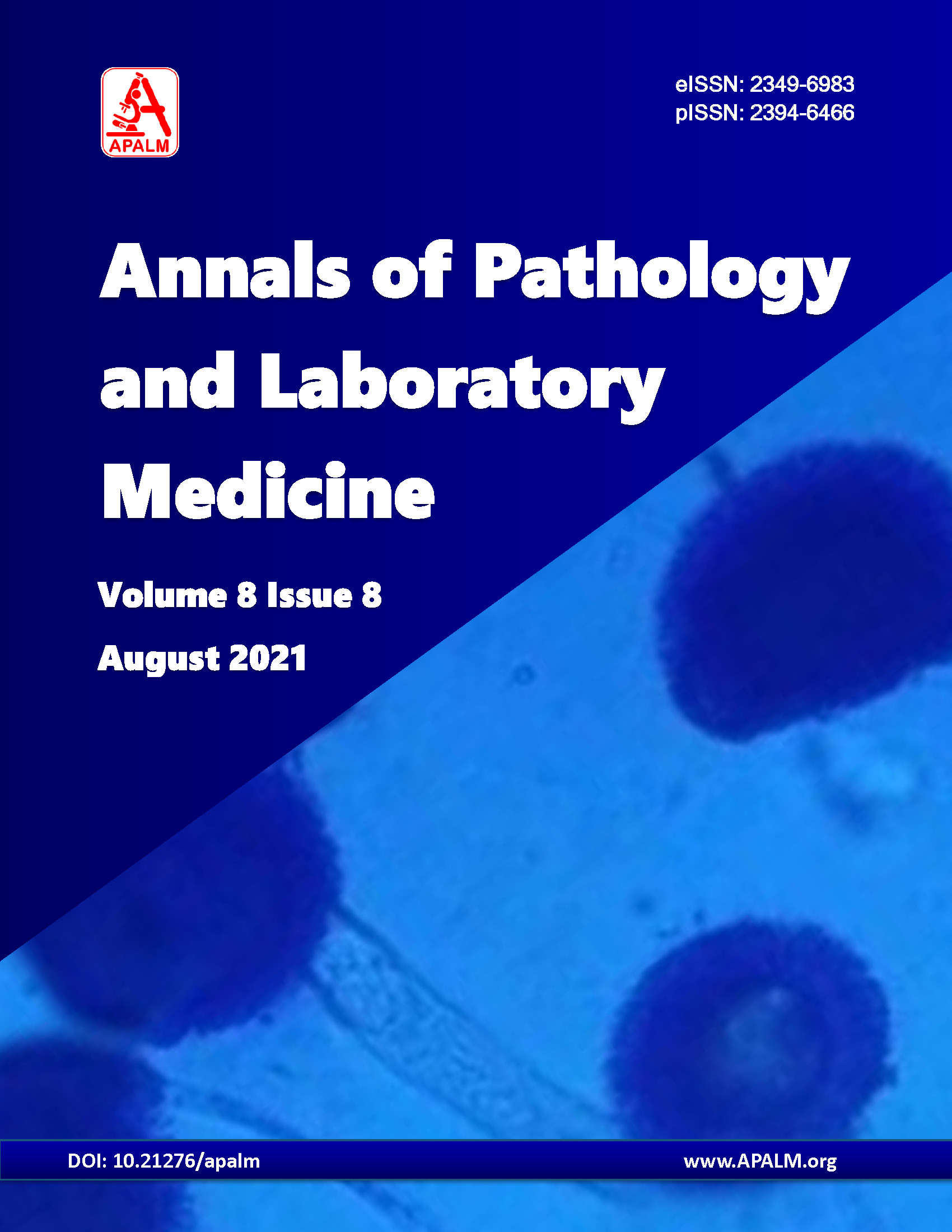Histopathological Study of Epithelial, Melanocytic And Adnexal Tumors Of Skin- A Retrospective Study In A Tertiary Care Centre
DOI:
https://doi.org/10.21276/apalm.3096Keywords:
Keratinocytic tumors, Melanocytic tumors, Hidradenoma, Spiradenoma, Basal cell Carcinoma, Squamous Cell CarcinomaAbstract
Background and objectives: To classify and identify various skin tumors and study their variations according to age and sex. The most common predisposing factors being fair skin, sun exposure, chemical exposure, HPV infection in the setting of immunosuppression.
Methods: This was an observational study carried out in the Department of Pathology at private Medical College of coastal Andhra from July 2018 to June 2020.
Result: The present study included histopathological study of 71 cases of tumors of skin and its adnexae over a period of two years. Out of the 71 tumors, 43 were diagnosed as benign and 28 as malignant tumors of skin constituting 61% and 39% respectively. The ratio of benign to malignant tumors was 1:0.63. Among the 43 benign tumors 20 (46.5%) were tumors of skin appendages, 15 (34.9%) were tumors of epidermis, 8 (18.6%) were of melanocytic origin. Among the 28 malignant tumors 25 (89.3%) were tumors of epidermis, 2 (7.1%) were melanocytic tumors and 1 (3.6%) was tumor of skin appendages. Among the malignant epidermal tumors squamous cell carcinoma was the most common constituting 42.9% (12 cases).
Conclusion: The present study concludes that benign tumors are most common when compared to malignant tumors of skin. Among the malignant tumors, Squamous cell carcinoma falls as the most common variety of skin followed by Basal cell carcinoma and verrucous carcinoma. Among the benign tumors, tumors of epidermal origin are most frequent followed by tumors of sweat gland and adnexal-hair follicle origin.
References
Montagna W, Kligman AM, Carlisle KS: Atlas of normal human skin. New York, Springer-Velag,1992.
Gloster HM Jr., Neal k. Skin cancer in skin of color. Jam Acad Dermatol 2006:55:741-60
Koh D, Wang H, Lee J Chia KS, Lee HP and Goh CL. Basal cell carcinoma, squamous cell carcinoma and melanoma of the skin:analysis of the Singapore Cancer Registry data 1968-97.British journal of Dermatology;148:1161-1166.
Godbole VK TopraniHT, Shah HH. Skin cancer in saurashtra.Ind J Pathol Bacteriol.1968;11:183-89.
Leboit PE, Burg G, Weedon D and Sarasin A. Pathology and genetics of skin tumors. In world health organization classification of tumors. IARC press.Lyon, 2006.p.9-164.
Requena L, Kiryu H, Ackerman AB (1998). Neoplasms with apocrine differentiation. Lippincott Williams & Wilkins: Philadelphia.
McCalmont TH (1996). A call for logic in the classification of adnexal neoplasms. Am J Dermatopathol 18: 103-109.
Klein W, Chan E and Seykora JT. Tumors of the epidermal appendages. In lever’s histopathology of skin. 9th ed. Philadelphia: Lippincott raven;2005. p.867-926.
Lober BA, Lober CW, Accola J (2000). Actinic keratosis is squamous cell carcinoma. J Am Acad Dermatol 43:881-882.
Deo SV, Hazarika Sidhartha, Shukla Nootan K, Kumar Sunil, Kar Madhabananda, Samaiya Atul Surgical management of skin cancers: Experience from a regional cancer centre in north india. Indian journal of cancer 2005.p.805-866.
Chakravorthy RC and Choudhuri DR. Malignant neoplasms of skin in Eastern india. The Indian journal off Cancer, vol 5.1968:133-144.
Bhudaraja SN, Pillai VCV, Periyanagam WJ, Kaushik SP and Bedi BMS. Malignant neoplasms of skin in Pondicherry- a study of 102 cases. The Indian journal of Cancer. 1972:284-295.
Solanki RL, Arora HL, Anand VK, GaurSK, Gupta R.Basal cell epithelioma( A clinicopathological study of 172 cases), Indian J Dermatology Venerology and leprology:1989 Vol 2 (55):33-43.
Nair SP. A clinicopathological study of skin appendageal tumors, Indian Journal of Dermatology, Venerology and Leprology 2008:74:108-550.
Reddy KM, Veliath AJ, Nagarajan S and Arora AL. A clinicopathological study of adnexal tumors of skin. Indian J Med Res 75, June 1982:882-889.
Downloads
Published
Issue
Section
License
Copyright (c) 2021 Sandhya Pitla, Vijayasri Dara

This work is licensed under a Creative Commons Attribution 4.0 International License.
Authors who publish with this journal agree to the following terms:
- Authors retain copyright and grant the journal right of first publication with the work simultaneously licensed under a Creative Commons Attribution License that allows others to share the work with an acknowledgement of the work's authorship and initial publication in this journal.
- Authors are able to enter into separate, additional contractual arrangements for the non-exclusive distribution of the journal's published version of the work (e.g., post it to an institutional repository or publish it in a book), with an acknowledgement of its initial publication in this journal.
- Authors are permitted and encouraged to post their work online (e.g., in institutional repositories or on their website) prior to and during the submission process, as it can lead to productive exchanges, as well as earlier and greater citation of published work (See The Effect of Open Access at http://opcit.eprints.org/oacitation-biblio.html).










